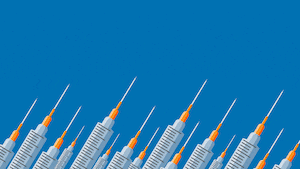The latest subvariant of the novel coronavirus to become dominant in Europe, the United States, and other places is also, in many ways, the worst so far.
The BA.5 subvariant of the basic Omicron variant appears to be more contagious than any previous form of the virus. It’s apparently better at dodging our antibodies, too—meaning it might be more likely to cause breakthrough and repeat infections.
Vaccines and boosters are still the best defense. There are even Omicron-specific booster jabs in development that, in coming months, could make the best vaccines more effective against BA.5 and its genetic cousins.
Still, BA.5’s ongoing romp across half the planet is a strong reminder that the COVID pandemic isn’t over. “We’re not done yet, by any stretch,” Eric Topol, founder and director of the Scripps Research Translational Institute in California, wrote on his Substack.
High levels of at least partial immunity from vaccines and past infection continue to prevent the worst outcomes—mass hospitalization and death. But globally, raw case numbers are surging, with serious implications for potentially millions of people who face a growing risk of long-term illness.
Equally worrying, the latest wave of infections is giving the coronavirus the time and space it needs to mutate into even more dangerous variants and subvariants. “The development of variants now is a freight train,” Irwin Redlener, the founding director of Columbia University’s National Center for Disaster Preparedness, told The Daily Beast.
In other words, unstoppable.
BA.5 first turned up in viral samples in South Africa in February. By May it was dominant in Europe and Israel, displacing earlier forms of the basic Omicron variant while also driving an increase in global daily COVID cases from around 477,000 a day in early June to 820,000 a day this week.
In late June, BA.5 became dominant in the United States. Cases haven’t increased yet—the daily average has hovered around 100,000 since May. But that could change in coming weeks as BA.5 continues to outcompete less transmissible subvariants.
Topol offered a concise explanation for BA.5’s ascendancy. Where the mutations that produced many earlier variants mostly affected the spike protein—the part of the virus that helps it to grab onto and infect our cells—BA.5 has mutations across its structure. “BA.5 is quite distinct and very fit, representing marked difference from all prior variants,” Topol wrote.
BA.5’s widespread mutations made the subvariant less recognizable to all those antibodies we’ve built up from vaccines, boosters and past infection. BA.5 has been able to slip past our immune systems, contributing to the rising rate of breakthrough cases and reinfections.
This comes as no surprise to epidemiologists who’ve warned for many months now that persistently high case-rates—which they largely attribute in part to a stubborn anti-vax minority in many countries—would facilitate ever more infectious and evasive variants and subvariant. The more infections, the more chances for significant mutations.

A young child receives a Moderna COVID-19 vaccination at Temple Beth Shalom in Needham, Massachusetts, on June 21, 2022.
Joseph Prezioso/AFP/GettyIn that sense, BA5 might be a preview of the months and years to come. A year ago, we had a chance to block SARS-CoV-2’s main transmission vectors through vaccines and social distancing.
But we didn’t. Restrictions on businesses, schools and crowds have become politically toxic all over the world. Vaccination rates remained stubbornly low, even in many countries with easy access to jabs. In the U.S., for example, the percentage of fully vaccinated has stalled at around 67 percent.
So COVID lingers, 31 months after the first case was diagnosed in Wuhan, China. The longer the virus circulates, the more variants it produces. BA.5 is the all but inevitable result of that tragic dynamic.
The situation isn’t entirely hopeless. Yes, BA.5 seems to reduce the effectiveness of the best messenger-RNA vaccines. Vaccine-maker Moderna published data indicating that a booster shot it’s developing specifically for Omicron and its offspring works only a third as well against BA.5 compared to earlier subvariants.
But vaccines, boosters and past infection still offer meaningful, if reduced, protection against BA.5. “Even a boost of the original genome, or a recent infection, will [produce] some cross-protective antibodies to lessen the severity of a new Omicron subvariant infection,” Eric Bortz, a University of Alaska-Anchorage virologist and public-health expert, told The Daily Beast.
The more additional jabs you get on top of your prime course, the better protected you are. Arguably the best protection results from two prime jabs of the mRNA vaccines from Pfizer or Moderna plus a couple boosters. “Get your damn fourth shot!” Redlener said.
The problem, in the United States, is that only people 50 years old or older or with certain immune disorders qualify for a second booster. And the U.S. Food and Drug Administration won’t say whether, or when, it might authorize second boosters for younger people. “I have nothing to share at this time,” an FDA spokesperson told The Daily Beast when asked about boosters for under-50s.

A girl gets a COVID-19 test at a testing station on July 7, 2022, in Shanghai, China.
Hugo Hu/GettyIt’s an obvious bureaucratic screw-up. As many as a million booster doses are about to expire in the U.S., all for a want of takers. “A profound waste, which should be made available to all people, age under-50 who seek added protection,” Topol wrote.
To be fair, Pfizer and Moderna are both working on new boosters that they’ve tailored specifically for Omicron subvariants. On June 30, an FDA advisory board endorsed these variant-specific boosters. The FDA announced it might approve them for emergency use for some Americans as early as this fall.
But there’s a risk these jabs will show up too late, especially if they’re highly optimized for just one recent subvariant and thus ineffective against future subvariants. “Variant-chasing is a flawed approach,” Topol wrote. “By the time a BA.5 vaccine booster is potentially available, who knows what will be the predominant strain?”
Fortunately, there are fallbacks. Masks and voluntary social-distancing, of course. Post-infection therapies including the antiviral drug paxlovid also help. “This is not a time to abandon non-pharmaceutical intervention,” Redlener stressed.
But voluntary mask-wearing and paxlovid are bandaids on a festering global wound. The surge in BA.5 infections creates the conditions for the next major subvariant—BA.6, if you will. It might be even worse.
It’s looking more and more likely that COVID will be with us, well, forever. “COVID is becoming like the flu,” Ali Mokdad, a professor of health metrics sciences at the University of Washington Institute for Health, told The Daily Beast.
That is, endemic. An ever-present threat to public health. The big difference, of course, is that COVID is much more dangerous than today’s flu. And it keeps mutating in ways that make it even worse.








